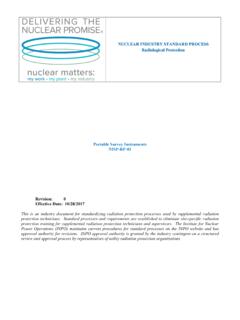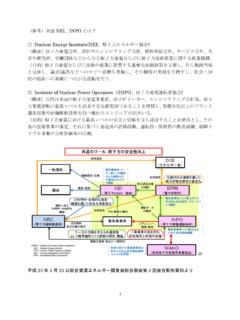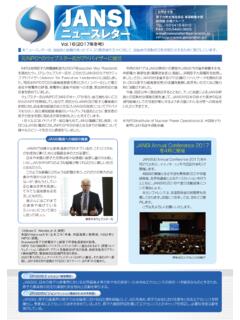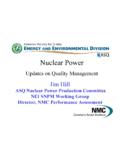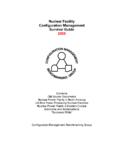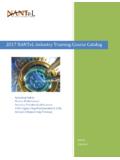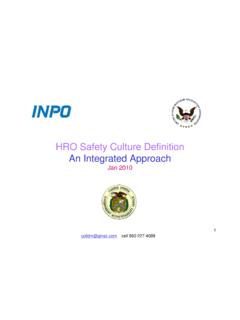Transcription of NUCLEAR INDUSTRY STANDARD PROCESS …
1 Personnel Contamination Monitoring NISP-RP-06 Revision: DRAFT Effective Date: 5-23-2017 This is an INDUSTRY document for standardizing radiation protection processes used by supplemental radiation protection technicians. STANDARD processes and requirements are established to eliminate site-specific radiation protection training for supplemental radiation protection technicians and supervisors. The Institute for NUCLEAR Power Operations (INPO) maintains current procedures for STANDARD processes on the INPO website and has approval authority for revisions. INPO approval authority is granted by the INDUSTRY contingent on a structured review and approval PROCESS by representatives of utility radiation protection organizations.
2 NUCLEAR INDUSTRY STANDARD PROCESS Radiological Protection NUCLEAR INDUSTRY STANDARD PROCESS Personnel Contamination Monitoring Document #: NISP-RP-06 Revision: Effective Date: 5-23-2017 Table of Contents Introduction .. 1 Purpose .. 1 Scope and Applicability .. 1 General Requirements .. 1 PROCESS .. 5 Respond to contamination monitor alarm .. 5 Determine contamination hazard .. 6 Personnel Decontamination .. 7 Dose assessment and documentation .. 8 Clarifying Notes .. 8 References .. 9 Attachment 1: Personnel Contamination Event - Sample .. 10 Attachment 2: Communication Guidelines .. 12 Attachment 3: PCE Classification Guidelines.
3 13 Attachment 4: Personnel Contamination Event Log - NUCLEAR INDUSTRY STANDARD PROCESS Personnel Contamination Monitoring Document #: NISP-RP-06 Revision: Effective Date: 5-23-2017 Page 1 of 14 Introduction Purpose This procedure describes the PROCESS for monitoring personnel for skin and clothing contamination and proper decontamination methods. Scope and Applicability This procedure describes the normal PROCESS for monitoring personnel assuming contamination monitors are operational. In the event equipment is not available site specific procedures will provide guidance to supplemental personnel. Documentation of personnel contamination events will be completed using site specific forms, electronic processes, or the attachments to this procedure.
4 Member utilities are expected to use this STANDARD to enable supplemental workers to transition between NUCLEAR power plants with minimal site-specific training. Compliance with these instructions is expected without additional site requirements or PROCESS deviations being imposed that may require additional training or challenge the performance of supplemental workers. This is an information use procedure that will be used to train and instruct supplemental radiological protection technicians. Member utilities may implement these PROCESS requirements in site procedures provided the site procedures are equivalent and updated whenever this NUCLEAR INDUSTRY STANDARD PROCESS (NISP) is revised.
5 Member utilities may also elect to delete equivalent site-specific procedures and use this procedure for training and instruction. Current revisions are maintained on the INPO website. Terms, acronyms, and definitions are provided in NISP-RP-013, Radiological Protection Glossary. Clarifying notes for requirements and PROCESS steps are provided in Section using superscript numbers in the preceding sections. General Requirements All personnel must exit through a beta and gamma sensitive monitor(s) prior to final exit from the RCA. Contamination monitoring may also occur inside the plant in locations where the background is suitable for monitoring. Personnel Contamination Events are classified using the following criteria.
6 7 Level 1 100 ccpm 5000 ccpm Level 2 >5000 ccpm 50,000 ccpm Level 3 >50,000 ccpm Skin dose assessment will be determined by the sites prospective determination or as defined in section 12 If there is no prospective determination that documents that individuals are not likely to receive in excess of 10 percent of the limits, recording and reporting is required under NRC regulations If the site has a documented prospective determination documenting that individuals are not likely to receive in excess of 10 percent of the limits, recording and reporting of identified contamination is voluntary, unless the exposure actually exceeds 5000 mrem in the calendar year.
7 NUCLEAR INDUSTRY STANDARD PROCESS Personnel Contamination Monitoring Document #: NISP-RP-06 Revision: Effective Date: 5-23-2017 Page 2 of 14 Use Attachment 3, PCE Classification Guideline, to determine if the cause of the alarm should be classified as a PCE. Alarm set points will be established by the site based on background, instrument efficiency, and hard to detect radionuclides and should alarm when 5000 dpm of radioactivity has been detected. Sensitivity to the individual s gender must be taken into consideration prior to survey and any decontamination actions. If an alarm occurs on a contamination monitor then take the following actions: Note the location of the alarm and the activity.
8 Instruct the individual to re-monitor. If no alarm occurs, the individual may exit or proceed to the final exit point for monitoring If second alarm occurs note the location and activity and proceed to step In the event of a second alarm, indicating a potential contamination event, immediately take the following actions: Take actions to prevent the spread of contamination in the surrounding area and to other personnel. In a background area of 200 cpm or less, using a frisker1 or equivalent instrument, and maintaining a detector to surface distance of approximately inch or less, slowly survey the individual with additional focus on suspected areas to determine the location and activity of contamination.
9 Ensure areas are surveyed which could have been partially shielded from the detectors such as arm pits, folds in clothing, or tops of shoes. Individuals can be contaminated in more than one location or by more than one radiological concern. Ensure the individual is thoroughly surveyed. 2 If the individual was working in an area posted and controlled for alpha contamination then perform a survey using an instrument capable of detecting alpha contamination. If alpha contamination is detected notify RP Supervision. 3 If the survey indicates the presence of discrete radioactive particles then capture and remove particles. 8 Using proper contamination controls capture the particle.
10 Note the location of the particle (skin or clothing). Document the survey results of the particle using a frisker, or if necessary, an open window ion chamber reading. If particle was found on clothing, survey and document the reading obtained on top and underneath the clothing ( area in contact with skin). 9 Secure the particle in the proper container and label as radioactive material. 4 Send the discrete particle for isotopic analysis. If the survey indicates facial contamination inside the area normally protected by the sealing surface of a respirator, then the potential for internal contamination exists. Shower the individual as appropriate and perform an in-vivo assessment.
